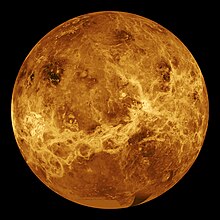 |
| Venus |
Venus is the second planet from the Sun. It is a fiery, hot planet which has mostly Carbon Dioxide. The size of the planet is nearly equal to that of Earth's, so its called as Earth's twin though its physically different from Earth except that it is rocky. Venus, since is covered by a Carbon Dioxide atmosphere, forms a thick cloud or a blanket over its surface and this atmosphere actually reflects 75%(approx.) of the sun light. Thus this planet is also called as the morning star and the evening star since it can be seen at dawn and at dusk. Early astronomers thought Venus was actually a star.
The planet looks extremely beautiful in the night sky and so has been named 'Venus' after the Roman Goddess of beauty and love.
Venus is a special planet. Its day is more than its year, i.e it takes lesser time to revolve around the Sun than rotate on its own axis.
- Rotational period(day): 243 Earth days.
- Revolution period(year): 224..7(225) Earth days.
- Aphelion: 108,942,109 km
- Perihelion: 107,476,259 km
- Speed: 35.019 km/s
- Radius: 6,051.8 ± 1.0 km
- Surface Area: 4.60×108 km2
- Escape Velocity: 10.46 km/s
- Volume: 9.38 X 1011 km3
- Mass: 4.868 5×1024 kg
- Acceleration due to gravity(g): 8.87 m/s2
Geology: There has been no information of its moment of inertia, so there is little direct information about the internal structure and geochemistry of Venus. However, the similarity in size and density between Venus and Earth suggests that they share a similar internal structure: a core, mantle, and crust. Like that of Earth, the Venusian core is at least partially liquid because the two planets have been cooling at about the same rate. The slightly smaller size of Venus suggests that pressures are significantly lower in its deep interior than Earth. The principal difference between the two planets is the lack of plate tectonics on Venus, likely due to the dry surface and mantle. This results in reduced heat loss from the planet, preventing it from cooling and providing a likely explanation for its lack of an internally generated magnetic field
Atmosphere: Venus has an extremely dense atmosphere, which consists mainly of carbon dioxide and a small amount of nitrogen. The atmospheric mass is 93 times that of Earth's atmosphere while the pressure at the planet's surface is about 92 times that at Earth's surface—a pressure equivalent to that at a depth of nearly 1 kilometer under Earth's oceans. The density at the surface is 65 kg/m³ (6.5% that of water). The CO2-rich atmosphere, along with thick clouds of Sulphur dioxide, generates the strongest greenhouse effect in the Solar System, creating surface temperatures of over 460 °C (860 °F). This makes the Venusian surface hotter than Mercury's which has a minimum surface temperature of −220 °C and maximum surface temperature of 420 °C, even though Venus is nearly twice Mercury's distance from the Sun and thus receives only 25% of Mercury's solarirradiance.
The first robotic space probe mission to Venus, and the first to any planet, began on February 12, 1961 with the launch of the Venera 1 probe. The first craft of the otherwise highly successful SovietVenera program, Venera 1 was launched on a direct impact trajectory, but contact was lost seven days into the mission, when the probe was about 2 million km from Earth.





0 comments:
Post a Comment